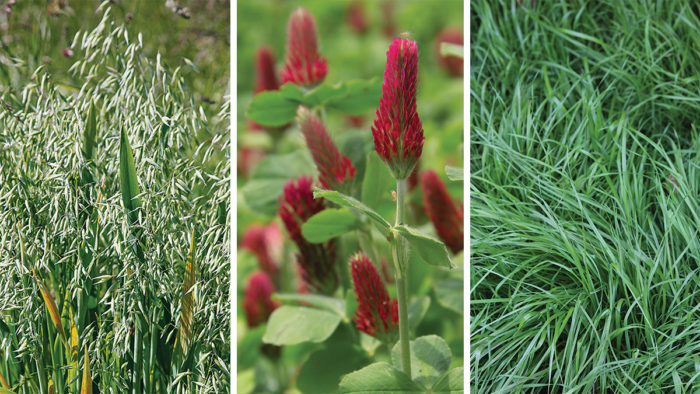
Typical cover crops are annuals, biennials, or short-lived perennials (three to five years). Each has its pros and cons. Here are a few of my favorite plants to use as cover crops.
Winter rye (Secale cereal)

This annual grain is adaptable to all soil types, including those with low fertility, low pH (acidic), and a high amount of sand. An important winter cover crop, it helps to suppress weeds through competition in the garden and an allopathic quality in its roots that inhibits weed germination. Gardeners use winter rye as the last crop of the growing season because it germinates in cool soil, when temperatures drop down to 35°F. It is often planted around the first frost date of fall; if it’s sown earlier, it can get a little too aggressive.
How to kill it: Winter rye can be mowed and left in place or mowed and tilled in early spring. A word of warning: Winter rye doesn’t die in winter, so time its killing to prevent it from going to seed. If you’re just going to mow it, allow the green debris to decompose in place for three to four weeks before you begin planting your beds.
Field peas (Pisum sativum)

Peas grow quickly in the cool seasons of spring and early fall, and they fix nitrogen right in the soil where future crops might need it. Before planting, pea seed should be inoculated with a microbial dust. Rhizobia are soil bacteria that take atmospheric nitrogen and convert it symbiotically into a form that plants can use. Growing in the soil around the pea roots, they eventually attach. When the peas die off, there is enough nitrogen in the root nodules left behind for subsequent plants to use. Plant peas by burying the seeds in the soil 1 to 2 inches deep.
How to kill it: Spring-planted peas will die off in late spring and can be left to decompose on their own or tilled in before immediately replanting the area. If peas are grown as a fall cover crop, their soft, succulent stems will die in winter and be decomposed by spring.
Oats (Avena sativa)

As a cool-season annual grass, spring oats vigorously germinates and becomes established quickly when planted in early spring. The abundant top growth and a fibrous root system help to build soil structure when tilled in. Good scavengers of phosphorus in the soil, oat plantlets capture additional soil nutrients, helping to restore soil fertility. Oats can be sown in the garden in spring or fall.
How to kill it: After six to 10 weeks of growing, spring-sown oats can be mown down and tilled in or left to decompose. Ideally this is done when the seed heads are still green. Fall oats can be planted through the third week in September, which ensures they will become established enough to prevent soil erosion through early winter. Oats won’t survive over winter in Zone 6 and colder, making them easy to till into the soil in spring.
Crimson clover (Trifolium incarnatum)

The prettiest cover crop of the bunch, crimson clover can be planted anytime during the growing season. The simple taproot of this annual legume mines and builds nitrogen in the soil. It is a smart choice for weed suppression, erosion control, and attracting pollinators.
How to kill it: Plan to mow it after it begins to show early budding. It may be hard to get rid of such a pretty planting; you can wait to mow until full bloom, but after a couple of days it will self-sow readily. If planted in fall, crimson clover will succumb to cold winter temperatures in Zone 5 and colder.
Ryegrass (Lolium multiflorum)

Local garden centers or farm stores have ryegrass available for planting in early spring or fall. Packages of seed usually contain the perennial type of ryegrass mixed with an annual type. Autumn-planted annual ryegrass dies in winter and is easy to till under in spring. Perennial ryegrass has an extensive root system and can be a bit more difficult to incorporate. Overall, ryegrass is an easy cover crop to establish in the cool seasons, with vigorous germination when given ample moisture. The optimum planting time is late summer to early fall for much of the country; wait until late fall and you’ll risk poor establishment if an early frost hits.
How to kill it: Ryegrass is best mowed in early spring. Since you may have a mix of perennial and annual seed, you may need to mow more than once and also smother to completely kill it. Allow green debris to decompose in place for three to four weeks before planting.
Oilseed radish (Raphanus sativus)

Compacted soils? Look no further than the humble radish. The ultimate clay buster, the taprooted oilseed radish breaks up poorly drained soils. Keep in mind that the radish used for cover cropping more closely resembles a daikon radish than a round red spring radish. Planting in midsummer allows the radish to gain girth and length enough to open holes in the soil. This allows for better infiltration of air, water, and small seedlings to root in the planting that follows.
How to kill it: Oilseed radish will naturally die in winter when temperatures fall below 20°F and will decompose naturally in the soil by spring.
More on cover crops
How to Use Cover Crops to Improve Soil
Lisa Hilgenberg is the head horticulturist of the Regenstein Fruit and Vegetable Garden at the Chicago Botanic Garden.

















Comments
I guess this is something we do and not the seed company? ---------- pea seed should be inoculated with a microbial dust. ----------- If so what brand, or name like Sevin do we look for? Do we cover it with dust and then plant? Thanks.
Log in or create an account to post a comment.
Sign up Log in